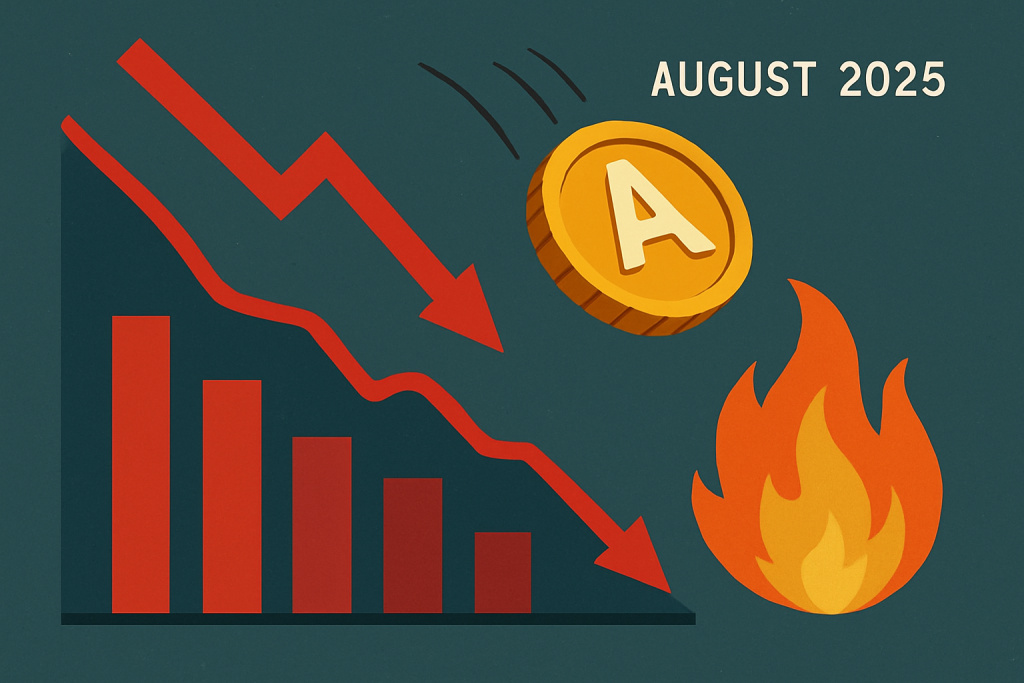Introduction
The cryptocurrency market is once again experiencing heightened volatility, sending shockwaves through the investment community. On August 5, 2025, a significant pullback gripped the crypto sector, led by steep declines in altcoins such as Solana, Avalanche, and other high-beta tokens. The downturn has prompted renewed fears about the sustainability of speculative assets in an increasingly uncertain macroeconomic environment. While Bitcoin and Ethereum held relatively firmer ground, the broader altcoin market was hit particularly hard, highlighting an ongoing shift in investor sentiment from high-risk assets to more stable positions.
Altcoins Bear The Brunt Of Market Selloff
Unlike previous corrections that saw uniform declines across the entire crypto market, the current pullback has disproportionately affected altcoins. Solana dropped more than 14 percent in just 48 hours, while Avalanche and Polygon experienced double-digit losses as well. This pattern reflects a broader risk-off environment where speculative assets with lower market capitalizations and higher volatility are the first to be sold off by traders and institutional players.
Many analysts have attributed the altcoin-focused crash to a mix of profit-taking, lack of new institutional inflows, and disappointing updates from several blockchain ecosystems. Additionally, several decentralized finance projects linked to these altcoins failed to generate meaningful adoption or revenue growth in recent months, fueling doubts about long-term sustainability.
Macroeconomic Pressure Intensifies Crypto Market Volatility
The volatility in the crypto market comes amid growing uncertainty in the global economy. Market participants have been closely watching the U.S. Federal Reserve’s tone, with recent comments hinting at a potential continuation of tight monetary policy. Even though inflation has somewhat cooled, the central bank’s caution about persistent economic overheating has made risk-sensitive assets like cryptocurrencies more vulnerable.
When the Fed signals prolonged rate hikes or slower-than-expected easing, liquidity in global markets tends to contract. As a result, speculative assets such as altcoins—already considered high-risk—lose favor among both retail and institutional investors. With U.S. treasury yields rising and traditional equities facing increased pressure, the knock-on effect on the crypto market is both direct and immediate.
Crypto’s unique dependence on investor sentiment, rather than strong fundamental earnings, makes it especially prone to macro-driven fluctuations. The current market whiplash is a clear reminder of how quickly sentiment can change in the digital asset space.
Retail And Institutional Investors React Cautiously
Investor reaction to the market downturn has varied across the board. Retail traders, who make up a large portion of the altcoin investor base, have shown signs of panic selling. Trading volumes on decentralized exchanges surged significantly during the crash, indicating that smaller investors are trying to exit their positions quickly.
On the other hand, institutional players appear to be taking a wait-and-see approach. Many funds have paused their crypto allocations amid the turbulence, while others are using this period to reassess risk exposure. Some investment firms, previously bullish on Layer 1 altcoins like Solana and Avalanche, have scaled back their positions in favor of more liquid assets like Bitcoin or even stablecoins.
One recurring theme among analysts is that institutional crypto investment is becoming more selective. Fund managers are now prioritizing tokens with clear use cases, steady developer activity, and relatively lower exposure to retail-driven speculation.
Solana And Avalanche: Case Studies Of Sharp Decline
Solana and Avalanche, two of the top altcoins hit hardest by the selloff, offer a glimpse into how ecosystem-specific issues can accelerate market declines. Solana, despite recovering from past outages and scaling issues, has recently struggled to retain developer momentum. A few high-profile decentralized applications built on Solana either pivoted to multi-chain models or failed to attract long-term users, diminishing the token’s utility narrative.
Avalanche, meanwhile, has faced challenges related to its subnet architecture and user engagement. Although the network positioned itself as a scalable Ethereum alternative, transaction volume and user retention have declined over the past quarter. With both networks under scrutiny, investor confidence has weakened, exacerbating price corrections.
Market Sentiment Tanks: Fear And Uncertainty Dominate
The recent crash has also significantly impacted market sentiment. According to sentiment tracking indices, such as the Bitcoin Fear and Greed Index, the crypto market has moved sharply into the “Extreme Fear” territory. This shift indicates a widespread lack of confidence among investors and a higher likelihood of further short-term corrections.
Social media chatter and Google search trends reflect this mood. Keywords like “crypto crash,” “should I sell Solana,” and “is Avalanche dead” have spiked over the last few days. These metrics underscore the fragile psychological state of retail investors, many of whom entered the market during the 2021–2023 bull runs and are now facing sustained losses.
Is This The Beginning Of A Prolonged Bear Phase?
While it is premature to declare a new extended bear market, the warning signs are hard to ignore. Altcoin performance often serves as a leading indicator of broader market trends. If risk appetite remains low and institutional demand does not return soon, the crypto market could see extended consolidation or even further downside.
However, some analysts remain cautiously optimistic. They argue that sharp pullbacks are healthy for long-term market maturity. By shaking out weak hands and low-utility projects, the downturn could pave the way for stronger fundamentals to emerge in the next cycle.
Technical analysts also note that the market is approaching key support zones. If these levels hold, it could set the stage for a rebound. Nevertheless, given the volatility, any potential recovery is likely to be uneven and fraught with short-term noise.
The Way Forward For Crypto Investors
For investors navigating the current market, caution and strategy are essential. Diversification, risk management, and long-term perspective remain the pillars of a resilient crypto portfolio. Rather than chasing hype-driven altcoins, analysts suggest focusing on projects with proven utility, transparent governance, and a committed developer community.
Additionally, keeping a close eye on macroeconomic indicators will be crucial. Crypto markets have become increasingly sensitive to interest rate changes, inflation data, and central bank commentary. Integrating these factors into a crypto investing framework can help investors anticipate and prepare for future volatility.
Conclusion
The August 2025 altcoin crash is shaping up to be a critical stress test for the broader cryptocurrency ecosystem. While Bitcoin and Ethereum continue to act as relative safe havens, altcoins are under intense scrutiny. With market sentiment rattled and investor behavior turning risk-averse, the coming weeks will reveal whether crypto can stabilize or faces deeper corrections.
The current downturn also highlights the sector’s ongoing need for maturation. Projects must prove their long-term value beyond speculative hype, and investors must adapt to a more complex and macro-driven environment. Regardless of whether this is a short-term dip or a longer bear phase, one thing is clear—the crypto market’s resilience is being tested once again.



